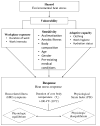Farmworker Vulnerability to Heat Hazards: A Conceptual Framework
- PMID: 28806486
- PMCID: PMC5656499
- DOI: 10.1111/jnu.12327
Farmworker Vulnerability to Heat Hazards: A Conceptual Framework
Abstract
Purpose: To review factors that impact the effect of hot environments on the human body in order to develop a conceptual model of human biological response.
Methods: The organizing concept for the model development was the multilevel integration of three major factors, exposure to heat, sensitivity and adaptive capacity, and the heat stress response. Exposure of a vulnerable occupational group was used to illustrate the components of the model.
Findings: Components of this framework include the hazard (environmental heat stress), vulnerability factors (workplace exposure, sensitivity and adaptive capacity), and the heat stress response. The combination of the vulnerability factors of workplace exposure (work intensity, duration), sensitivity (age, gender, etc.), and adaptive capacity (hydration, clothing, work hygiene) mediate a worker's heat stress response to the hazard. A worker's heat stress response can be classified as progressing towards two outcomes: physiologic equilibrium or physiologic disequilibrium.
Conclusions: This framework provides a starting point for the design and development of studies of heat-related illness (HRI) in farmworker and other vulnerable populations exposed to rising global temperatures.
Clinical relevance: Identification of vulnerability factors to HRI, informs research designs which will lead to the development of public health interventions.
Keywords: Heat-related illness; climate; farmworker; vulnerability.
© 2017 Sigma Theta Tau International.
Figures
Similar articles
-
Classification of Heat-Related Illness Symptoms Among Florida Farmworkers.J Nurs Scholarsh. 2018 Jan;50(1):74-82. doi: 10.1111/jnu.12355. Epub 2017 Oct 12. J Nurs Scholarsh. 2018. PMID: 29024370
-
Development of a heat vulnerability index for New York State.Public Health. 2018 Aug;161:127-137. doi: 10.1016/j.puhe.2017.09.006. Epub 2017 Dec 1. Public Health. 2018. PMID: 29195682
-
Assessment of heat stress contributing factors in the indoor environment among vulnerable populations in Klang Valley using principal component analysis (PCA).Sci Rep. 2024 Jul 15;14(1):16265. doi: 10.1038/s41598-024-67110-w. Sci Rep. 2024. PMID: 39009671 Free PMC article.
-
Heat stress and public health: a critical review.Annu Rev Public Health. 2008;29:41-55. doi: 10.1146/annurev.publhealth.29.020907.090843. Annu Rev Public Health. 2008. PMID: 18031221 Review.
-
The epidemiology of occupational heat exposure in the United States: a review of the literature and assessment of research needs in a changing climate.Int J Biometeorol. 2014 Oct;58(8):1779-88. doi: 10.1007/s00484-013-0752-x. Epub 2013 Dec 11. Int J Biometeorol. 2014. PMID: 24326903 Free PMC article. Review.
Cited by
-
Alignment and contribution of nursing doctoral programs to achieve the sustainable development goals.Hum Resour Health. 2020 Nov 7;18(1):86. doi: 10.1186/s12960-020-00530-7. Hum Resour Health. 2020. PMID: 33160380 Free PMC article.
-
Examining Agricultural Workplace Micro and Macroclimate Data Using Decision Tree Analysis to Determine Heat Illness Risk.J Occup Environ Med. 2019 Feb;61(2):107-114. doi: 10.1097/JOM.0000000000001484. J Occup Environ Med. 2019. PMID: 30335678 Free PMC article.
-
Application of the socioecological model to mitigate risks of heat illness.Nurs Outlook. 2024 May-Jun;72(3):102150. doi: 10.1016/j.outlook.2024.102150. Epub 2024 Mar 4. Nurs Outlook. 2024. PMID: 38442464 Free PMC article.
-
Enhancing detection of labor violations in the agricultural sector: A multilevel generalized linear regression model of H-2A violation counts.PLoS One. 2024 May 17;19(5):e0302960. doi: 10.1371/journal.pone.0302960. eCollection 2024. PLoS One. 2024. PMID: 38758737 Free PMC article.
-
"I Think the Temperature was 110 Degrees!": Work Safety Discussions Among Hispanic Farmworkers.J Agromedicine. 2019 Jan;24(1):15-25. doi: 10.1080/1059924X.2018.1536572. Epub 2018 Oct 26. J Agromedicine. 2019. PMID: 30317928 Free PMC article.
References
-
- American Congress of Government and Industrial Hygienists. Threshold limit values for chemical substances and physical agents and biological exposure indices. Cincinnati, OH: Author; 2014.
-
- Åström DO, Bertil F, Joacim R. Heat wave impact on morbidity and mortality in the elderly population: A review of recent studies. Maturitas. 2011;69(2):99–105. - PubMed
-
- Becker JA, Stewart LK. Heat-related illness. American Family Physician. 2011;83(11):1325–1330. - PubMed
-
- Bernard TE, Barrow CA. Empirical approach to outdoor WBGT from meteorological data and performance of two different instrument designs. Industrial Health. 2013;51(1):79–85. - PubMed
Publication types
MeSH terms
Grants and funding
LinkOut - more resources
Full Text Sources
Other Literature Sources
Medical


